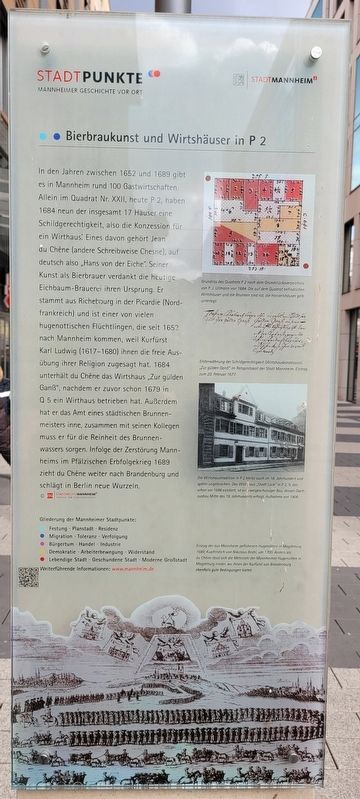Mannheim, Baden-Württemberg, Germany — Central Europe
Bierbraukunst und Wirtshäuser in P 2 / Beer Brewing and Taverns in P 2
Inscription.
In den Jahren zwischen 1652 und 1689 gibt es in Mannheim rund 100 Gastwirtschaften. Allein im Quadrat Nr. XXII, heute P 2, haben 1684 neun der insgesamt 17 Häuser eine Schildgerechtigkeit, also die Konzession für ein Wirthaus. Eines davon gehört Jean du Chêne (andere Schreibweise Chesne), auf deutsch also „Hans von der Eiche". Seiner Kunst als Bierbrauer verdankt die heutige Eichbaum-Brauerei ihren Ursprung. Er stammt aus Richebourg in der Picardie (Nordfrankreich) und ist einer von vielen hugenottischen Flüchtlingen, die seit 1652 nach Mannheim kommen, weil Kurfürst Karl Ludwig (1617-1680) ihnen die freie Ausübung ihrer Religion zugesagt hat. 1684 unterhält du Chêne das Wirtshaus „Zur gülden Ganß", nachdem er zuvor schon 1679 in Q 5 ein Wirthaus betrieben hat. Außerdem hat er das Amt eines städtischen Brunnenmeisters inne, zusammen mit seinen Kollegen muss er für die Reinheit des Brunnenwassers sorgen. Infolge der Zerstörung Mannheims im Pfälzischen Erbfolgekrieg 1689 zieht du Chêne weiter nach Brandenburg und schlägt in Berlin neue Wurzeln.
Bildunterschriften
Grundriss des Quadrats P2 nach dem Grundstücksverzeichnis von P. J. Ullmann von 1684. Die auf dem Quadrat befindlichen Wirtshäuser und die Brunnen sind rat, die Handelshäuser gelb unterlegt.
Ersterwähnung der Schildgerechtigkeit (Wirtshauskonzession) Zur gülden Ganß" im Ratsprotokoll der Stadt Mannheim, Eintrag zum 20. Februar 1677.
Die Wirtshaustradition in P 2 bleibt auch im 18. Jahrhundert und später ungebrochen. Das Wirt lous Stadt Lück in P 2, 9, das schon vor 1688 existiert, ist el zweigeschossiger Bau, dessen Dach ousbau Mitte des 19. Jahrhunderts erfolgt. Aufnahme von 1908.
Einzug der aus Mannheim gefionenen Hugenotten in Magdeburg 1689; Kupferstich von Nikolaus Brühl, um 1700. Anders als du Chêne lässt sich die Mehrzahl der Mannheimer Hugenotten in Magdeburg nieder, wo ihnen der Kurfurst von Brandenburg ebenfalls gute Bedingungen bietet.
Between 1652 and 1689 there were around 100 inns in Mannheim. In square number XXII alone, today P 2, in 1684 nine of the 17 houses had a shield, i.e. the license for an inn. One of them belongs to Jean du Chêne (other spelling Chesne), in German "Hans von der Eiche". Today's Eichbaum brewery owes its origins to his art as a beer brewer. He comes from Richebourg in Picardy (northern France) and is one of many Huguenot refugees who have been coming to Mannheim since 1652 because
Elector Karl Ludwig (1617-1680) promised them the freedom to practice their religion. In 1684, du Chêne ran the “Zur gülden Ganß” inn after he had already done so in 1679 in Q 5. He also holds the position of municipal well master; together with his colleagues, he has to ensure the purity of the well water. As a result of the destruction of Mannheim in the War of the Palatinate Succession in 1689, du Chêne moved on to Brandenburg and put down new roots in Berlin.
Captions
Floor plan of square P 2 based on P. J. Ullmann's property register from 1684. The inns and fountains on the square are shown, the trading houses highlighted in yellow.
First mention of the shield justice (tavern license) "Zur gülden Ganß" in the council minutes of the city of Mannheim, entry for February 20, 1677.
The pub tradition in P 2 remained unbroken in the 18th century and later. The inn in Stadt Lück at P 2, 9, which existed before 1688, is a two-story building whose roof was built in the middle of the 19th century. Photo from 1908.
Entry of the Huguenots from Mannheim into Magdeburg in 1689; Engraving by Nikolaus Brühl, around 1700. Unlike du Chêne, the majority of Mannheim's Huguenots settled in Magdeburg, where the Elector of Brandenburg also offered them good conditions.
Erected by Stadtpunkte Mannheimer Geschichte Vor Ort and Stadt Mannheim.
Topics. This historical marker is listed in this topic list: Industry & Commerce. A significant historical date for this entry is February 20, 1677.
Location. 49° 29.236′ N, 8° 28.081′ E. Marker is in Mannheim, Baden-Württemberg. Marker is at the intersection of Planken and P 3, on the right when traveling west on Planken. The marker is located at the corner of the street. Touch for map. Marker is at or near this postal address: P3 1A, Mannheim BW 68161, Germany. Touch for directions.
Other nearby markers. At least 8 other markers are within walking distance of this marker. Badische Bank O 4, 4 (within shouting distance of this marker); Strohmarkt und Planken / Straw Market and Planks (about 150 meters away, measured in a direct line); Altes Rathaus / Old Town Hall (about 210 meters away); Harmonie-gesellschaft / Harmony Society (about 210 meters away); Die Klaussynagoge / The Klaus Synagogue (about 240 meters away); Marktplatzbrunnen / Market Square Fountain (approx. 0.3 kilometers away); Mannheim-Gen (approx. half a kilometer away); SAP (approx. half a kilometer away). Touch for a list and map of all markers in Mannheim.
Also see . . . Huguenots. Wikipedia
The Huguenots were a religious group of French Protestants who held to the Reformed (Calvinist) tradition of Protestantism. The term, which may be derived from the name of a Swiss political leader, the Genevan burgomaster Besançon Hugues (1491–1532), was in common use by the mid-16th century. Huguenot was frequently used in reference to those of the Reformed Church of France from the time of the Protestant Reformation. By contrast, the Protestant populations of eastern France, in Alsace, Moselle, and Montbéliard, were mainly Lutherans.(Submitted on March 1, 2024, by James Hulse of Medina, Texas.)
Credits. This page was last revised on March 6, 2024. It was originally submitted on February 29, 2024, by James Hulse of Medina, Texas. This page has been viewed 65 times since then. Photos: 1, 2. submitted on March 1, 2024, by James Hulse of Medina, Texas.

